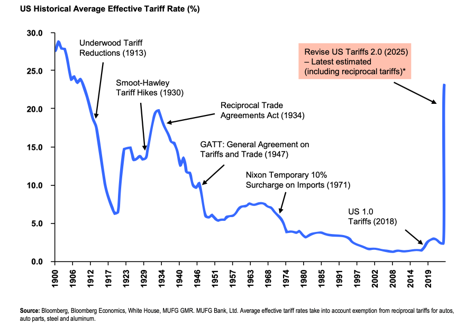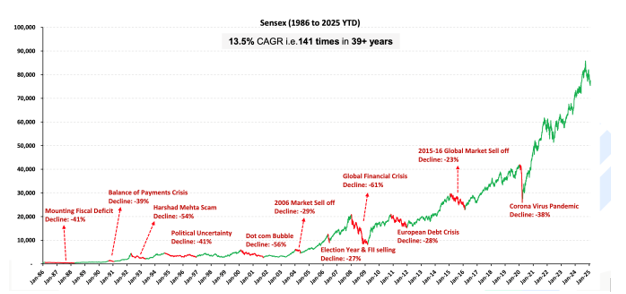Liberation Day – Not for the Investors!!
As we start a new financial year, we wish all our readers good health, prosperity and happiness.
The Tariff announcements by the US President Donald Trump on 2nd April was awaited by the entire world. Stiff reciprocal tariffs were announced on more than 60 countries. Let us try to understand more about the tariffs, how Indian markets and policy makers are reacting and finally how we should look at our investments in such an environment.
Executive Summary
- US Tariff announcements in 2025 – if implemented in totality, this will cause significant disruptions to the global economy. However, we are in the early stage and multiple negotiations and events will happen over the next few months before we get clarity.
- Financial markets have reacted adversely in the short run as markets hate uncertainty. Any short term market falls are good long term investment opportunities.
- India is relatively better off but we cannot escape the turmoil completely. Our economy has a strong domestic focus and various policy measures are being taken.
- As investors we need to remain calm, and invest if long term capital is available based on individual asset allocation. Diversification always makes sense and those who stay invested, will benefit enormously in the long run.
The best one line summary for what we should be doing would be from billionaire hedge fund investor David Tepper. When he was asked about how we can be successful investors he said the following
“The key is to wait. Sometimes the hardest thing to do is to do nothing.”
Please do read ahead for the details.
1. US Tariff Details
2. Financial Market Reactions
3. Impact on India
4. What we should be doing as Investors
5. What we should NOT be doing as Investors
1. US Tariff announcements – observe, understand and await clarity
At the outset, it is important to understand that the whole tariff story is still unfolding. The full story is not yet complete. So we should not jump to conclusions. The US President Trump believes that tariffs are an effective way to bring back manufacturing jobs to USA. He feels that by levying tariffs on countries, he will get better bargaining power for bilateral trade pacts
What do we know about Tariffs now?
The tariff announcements if implemented will be the highest in a century. Please see below chart.

China, Mexico and Canada are facing additional import tariffs from February and March 25 onwards. The April 2nd announcements of reciprocal tariffs were a continuation of these tariff announcements covering 60 countries. Along with a minimum baseline tariff of 10%, steep tariffs were announced for key trading partners like China, European Union and Asia.
- Asia got hit extensively with China (34%+20%), Cambodia (49%), Vietnam ( 46%), Bangladesh (37%) and Taiwan (32%) facing the brunt.
- The tariff imposed on India is 26%.
While the US has announced measures from their side, impacted countries will take time to respond and there are many unknowns.
What are the “Known Unknowns” ?
- What are the counter measures ( China, Canada and Mexico have already announced counter tariffs on USA) which will be announced by the impacted countries?
- Are the tariff announcements a negotiating tactic by the USA to bring trading partners to the table? Do they want to sign bilateral trade agreements with every major trading partner?
- Will other tactics like local stimulus, expansion in non-US Trade pacts gather pace?
- Is this a long term change or a short term decision? Or tariffs there to stay for the long term?
- When will we see policy stability? – for e.g. on April 2nd, it was announced that pharmaceuticals will be out of scope. Subsequently, the President has announced that it will be in scope with a separate policy!
2. Financial Market Reactions – Global markets, Oil prices and Interest rates are all down
The tariffs have sparked fears of a global recession leading to both stock market falls as well as a steep drop in oil prices.
- The US stock markets are down about 11% from record highs in Feb – We must understand that the US markets are coming off record highs. Unlike India, when Trump took charge there was extreme optimism and the markets moved up from Oct 24 and hit record highs by Feb 25. That optimism is wearing off now.
- Short term reactions from volatility targeting indexes – as per JP Morgan, such volatility targeting indices have sold about 40 Billion USD in stocks with another 25 to 30 Billion to come soon. These are short term reactions, while US retail investors continue to buy stocks.
- Oil prices have crashed to 65$/barrel – This is a multi year low with Oil hitting prices last seen during the covid crisis. Falling oil prices are great for India from a standalone viewpoint.

Every single time there is a market fall, in the long run the markets have recovered. While the short term reaction is extremely, greater clarity is awaited in the coming weeks.
3.Impact on India – We are relatively well off, but will need to manage the oncoming changes
The major challenge which Indian companies would have to overcome is the second order impact of global slowdowns. This will adversely impact sectors like IT. While we are “relatively” insulated at this moment, we cannot avoid the impact of such global slowdowns.
- Indian government policy measures – The Indian government has been proactively addressing the tariff challenge by engaging with the US government:
- In the February budget itself, import duty on specific products (motorcycles above 1600cc, bourbon whiskey, EV and mobile components, etc.) were reduced.
- Large procurements and agreements in the areas of defense and nuclear energy are expected.
- Active negotiations are ongoing for a Bilateral Trade Agreement, with an initial target date of Sept/Oct 2025. India has been discussing this agreement with the US from early 2025 onwards.
- The RBI is working closely with the Government to increase liquidity in the system by cutting interest rates and injecting liquidity through Open Market Operations.
- Indian stock markets are seeing stock/industry specific corrections – Over the last 6 months the Indian stock markets have seen broad corrections after a strong bull run. After the corrections, we are now seeing stock/industry specific price action.
- Overall we see the following positives for the market from a tariff viewpoint:
- Our largest service sectors – Information Technology and Knowledge processing still remain outside the ambit of the current tariffs.
- Currently Pharma is also not subject to any tariffs (this may change).
- We do not have significant auto exports to the US (except for impact on select stocks).
- Various defensive sectors focused on domestic consumption (e.g. hospitals, insurance, utilities, FMCG, local travel) are not impacted.
- o A major concern over the last 6 months was the rising US treasury yield. From a peak of 4.75% this has already dropped to 4% which is a positive for emerging markets.
- o Indian 10 year government security yields have also dropped to 6.6%.
4.What should we be doing as Investors? Wait and ride out the storm gradually with a specific strategy
Time in the market is very important to make long term money. This is not the first crisis, we have faced, nor will it be the last. Please see the past track record over 40 years through various events.

Source: Funds India research, ACE MF
- Be ready for the long haul and stagger investments – In our Feb 25 budget note also we had suggested that 2025 is the year to build the portfolio through the year. If long term capital is available, it should be invested in a staggered manner. One should not expect immediate returns and short term jumps until there is policy clarity.
- Target segments not affected by this uncertainty – In the short run, liquidity impacts all sectors. We are working with fund managers who are building portfolios in segments which are not impacted by the tariffs (private banks, consumption, healthcare).
- Diversification is a must – Multi Asset strategies continue to be a good way to navigate the market – Fixed income and gold have been clear winners in the past year. It is important to maintain a diversified strategy and avoid chasing recent winners (trying to take exposures to gold or silver now may be sub optimal in the short run).
- Take advantage of the ‘Uncertainty’ – Equity markets hate uncertainty. We get good long term buying opportunities only during such phases (geo political tensions, virus, adverse policy changes etc.). The current phase is one such opportunity.
5.What we should NOT be doing as Investors?
Time in the market is very important to make long term money. This is not the first crisis, we have faced, nor will it be the last. Please see the past track record over 40 years through various events.

Taking Constant Action – It will take time for policy measures to play out. We need to have the patience to wait through the cycle and stick to our proven investment strategies for the long haul. Our fund managers are constantly evaluating the opportunities in the markets and will position the portfolios accordingly.
Getting anchored to past prices and behaviours – After a multiyear bull run, the US technology stocks are seeing a correction. Avoid buying such price falls now. Until clarity emerges in the US, buying into the US tech sector may be sub optimal.
Making Lumpsum investments – With so much uncertainty we should avoid doing one time lumpsum investments based on news flow. It is better to stagger and invest the money.
Take extreme positions based on media articles – To capture eyeballs it is very common to see extreme reactions, both in the traditional and social media. It is important not to get influenced on either side (extreme negative or positive news). One should remain calm and resist the temptation to jump to quick conclusions.
More clarity will emerge in the coming months. We need to remain cautiously optimistic and avoid any knee jerk reactions. It is very important not to get swayed by the flood of opinions and views across different media. Wish you happy, successful long term investing !


